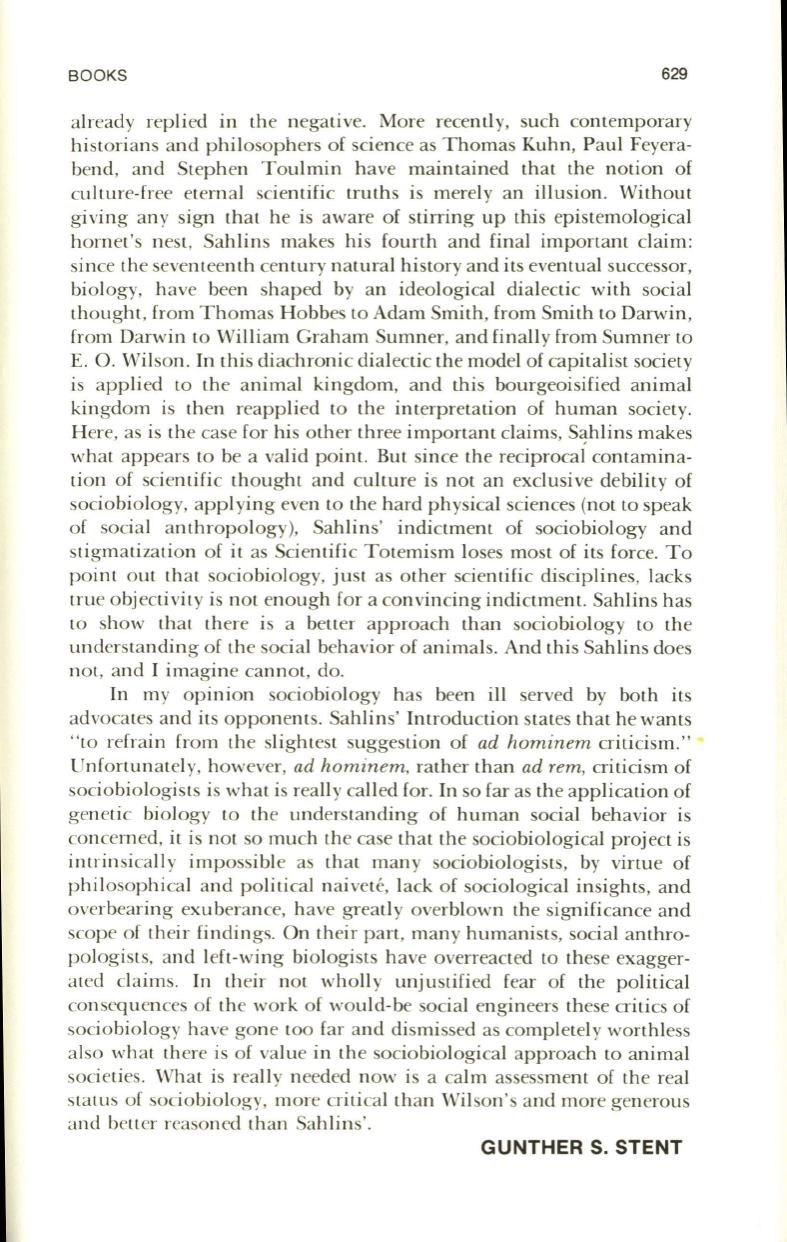
BOOKS
629
already replied in the negative. More recentl y, such contemporary
hi storians and philosoph ers of science as T homas Kuhn , Paul Feyera–
bend , and Steph en Toulmin have maintained that the notion of
culture-free etern al scientifi c truths is merely an illusion. Without
g iving any sign tha t he is aware of stirring up this epistemological
hornet's n es t, Sahlins makes hi s fourth and fin al important cl aim:
since the seventeenth century natural history and its eventual successor,
bi ology, have been shaped by an ideological di alectic with social
tho ugh t, fr om T homas Hobbes
to
Adam Smith, from Smith to Darwin,
from Darwin to Willi am Graham Sumner, and fin all y from Sumner to
E. O. Wilson . In thi s di ach ronic dialecti c the model of capitali st society
is appli ed to the animal kingdom, and thi s bourgeoisifi ed animal
kingdom is th en reapplied to the interpreta tion of human society.
Here, as is the case for hi s other th ree important claims,
S~hlins
makes
wha t appears
to
be a valid po int. But since the reciproca l contamina–
ti on of scientifi c thought and culture is not an exclusi ve debility of
sociobi ology, appl ying even to the hard physical sciences (not to speak
of social anth ropo logy), Sahlins' indictment of socio biol ogy and
sti gmati za ti on of it as Scienti fic T otemi sm loses most of its force. T o
po int out tha t socio bi ology, just as o ther scientific disciplines, lacks
true o bj ecti vity is not enough for a convincing indi ctment. Sahlins h as
to show tha t there is a better approach than sociobi ology to the
un derstanding of the social behavior of animals. And thi s Sahlins does
not, and I imagin e canno t, do.
In my opinion sociobi ology has been ill served by both its
advoca tes and its opponents. Sahlins' Introducti on sta tes tha t he wants
"to
refrain from the sli ghtes t suggesti on of
ad hom in em
criti cism."
Un fo rtuna tely, however,
ad hom inem,
ra ther than
ad rem,
criti cism of
sociobi o logists is what is rea ll y call ed for. In so far as the applicati on of
geneti c bio logy to the understanding of human social behavior is
concerned, it is no t so much the case tha t the sociobiological proj ect is
intrin sicall y impossibl e as tha t man y sociobiologists, by virtue of
phil osophi cal and politi cal naivete, lack o f sociological insights, and
overbearin g exuberance, have grea tl y overbl own the signifi cance and
scope of their findin gs. On their pa rt, many humanists, social anthro–
po log ists, and left-wing bi ologists have overreacted to these exagger–
a ted cl a ims. In their not who ll y unjustifi ed fea r of the political
consequ en ces of th e work of would-be social engineers these criti cs of
sociobi o logy have gone too far and di smissed as completely worthl ess
a lso wh at th ere is of va lue in th e socio bio logica l approach to animal
societi es. Wha t is reall y needed now is a calm assessment of the rea l
sta tus of sociobi o logy, more criti cal than Wil son 's and more generous
and better reasoned than Sahlins'.
GUNTHER S. STENT


